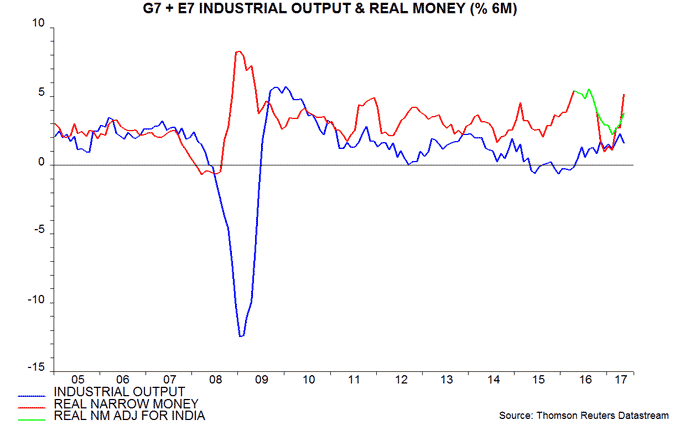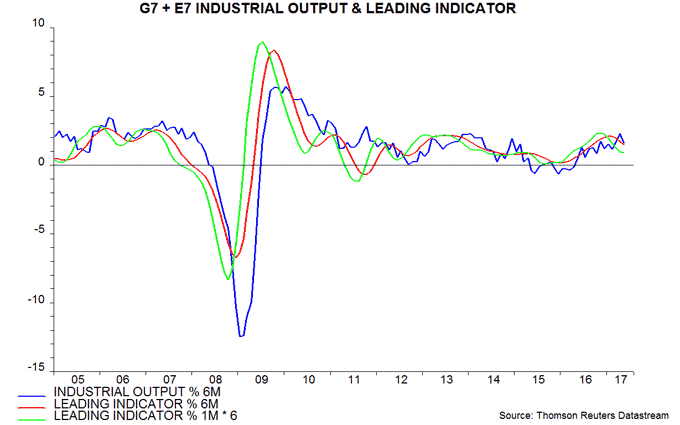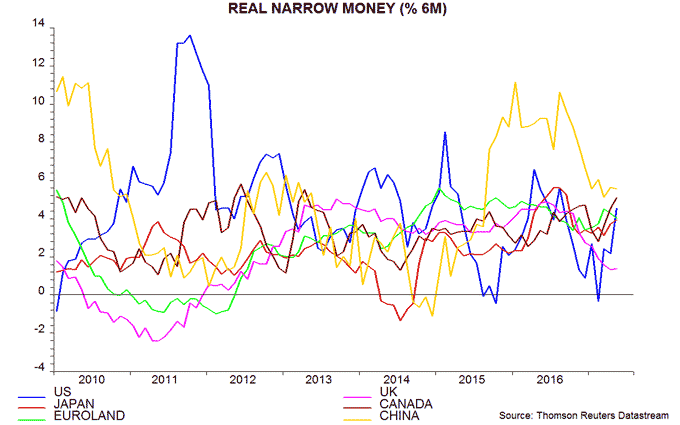A "monetarist" perspective on current equity markets
Global monetary trends suggest that economic growth will slow over the summer / autumn before strengthening again in late 2017. Major central banks are likely to proceed with plans for stimulus withdrawal despite weaker near-term momentum, reflecting concern about stretched labour markets. Stronger growth later in 2017 may accelerate policy tightening. Equity markets are at risk from earnings disappointments and / or rising rates. Relative money trends suggest adding US and Japanese exposure at the expense of Europe and emerging markets.
Previous commentaries argued that global economic momentum would slow from a peak in spring 2017. Recent news is consistent with this forecast. Six-month growth of industrial output in the G7 developed economies and seven large emerging economies (the “E7”) reached a three-year high in April before falling in May. J P Morgan’s global manufacturing purchasing managers’ index has eased back from a February / March peak. Citigroup’s G10 economic surprise index, meanwhile, turned negative in June, having been strongly positive earlier in 2017.
The basis for the forecast was a fall in G7 plus E7 real narrow money* growth from a peak in August 2016 – monetary trends lead the economy by about nine months on average. The decline was exaggerated by India’s “demonetisation” programme but an adjusted** real money growth measure also declined significantly – see first chart. The slowdown signal from monetary trends was subsequently confirmed by a shorter-term global leading indicator derived from the OECD’s country leading indicators – second chart.

Adjusted real narrow money growth, however, reached a low in February 2017, recovering solidly through May. Allowing for the average nine-month lead, this suggests a revival in economic momentum in late 2017 / early 2018. Confidence in such a scenario will increase if growth of the leading indicator bottoms out over the summer – its average lead time is about four months, i.e. turning points typically lag those for real money by about five months.
The suggested economic scenario is potentially negative for equity markets. Slower near-term growth would probably be associated with earnings undershooting forecasts – the MSCI All-Country World revisions ratio, indeed, turned negative in June, following a seven-month positive run. Major central banks, however, are focused on inflationary risks from stretched labour markets and would be likely to play down a modest weakening of activity data. The G7 unemployment rate fell to 5.1% in May, the lowest since 1980. A growth revival in late 2017, meanwhile, could trigger faster policy tightening.
The third chart shows that a rebound in US real money growth has been a key driver of the rise in the global measure. Canadian and Japanese trends have also improved, while Chinese growth has stabilised after a significant decline. 
Why has US money growth recovered despite Fed rate hikes? One explanation relates to a change in money market fund regulations in 2016. The immediate impact of this change was to encourage a switch in the assets of money funds out of bank deposits and commercial paper into Treasury securities. This shift pushed up banks’ funding costs, with a negative effect on lending and money growth. The three-month LIBOR / Treasury bill yield spread rose from 24 bp in November 2015 to a peak of 55 bp in September 2016.
The portfolio shift, however, appears to have been completed by late 2016. The LIBOR / T bill spread was back at 25 bp in June 2017. Easier funding conditions may have offset the negative impact on money / credit trends of Fed policy tightening. Bank lending as well as narrow money has picked up since early 2017. This explanation suggests that the regulatory change was a headwind for the economy and policy rates in 2016 but is now acting as a tailwind.
Chinese economic growth may hold up during the second half despite recent softer money / credit trends. Real money growth remains at a respectable level – third chart. The earlier monetary surge was reflected in a pick-up in inflationary pressures rather than a significantly stronger economy – fourth chart. The monetary slowdown, similarly, appears to be mainly affecting price momentum – producer prices have stabilised after surging in late 2016 / early 2017. Falling inflation gives the PBoC scope to reverse recent policy tightening to support growth, if necessary.
Strong Euroland business surveys have encouraged hopes that economic growth is ratcheting higher. Monetary trends, however, remain stable, suggesting that GDP will expand at around its recent pace (1.9% in the year to the first quarter of 2017). Surveys may have been boosted by a temporary “Macron effect”. Unemployment continues to fall rapidly and is on course to reach estimates of the “equilibrium” rate in 2018. The Fed was wrapping up QE at the equivalent US stage in 2014. The ECB may accelerate plans for stimulus withdrawal during the second half.
Recent rises in US and Japanese real money growth, coupled with possibly excessive optimism about Euroland economic prospects and weak UK money trends, suggest increasing US / Japanese equity market exposure at the expense of Europe. The US, in addition, would probably outperform in a general pull-back, while official buying might support Japanese stocks. The BoJ remains the most dovish of the major central banks, though may be forced to lift the zero yield cap during the second half if global yields climb.
Real money growth in the E7 emerging economies moved above the G7 level in late 2015, arguing that relative economic and equity market prospects were improving. Adjusted for the Indian demonetisation distortion, the E7 / G7 gap remained positive until recently – fifth chart. Emerging market equities could struggle in a market pull-back or if a stronger US economy forces the Fed to accelerate tightening, a scenario that would probably be associated with upward pressure on the US dollar.
*Narrow money = currency in circulation plus demand deposits and close substitutes. Broad money = narrow money plus time deposits, notice accounts, repos and bank securities. Precise definitions vary by country. Narrow money has been more reliable than broad money for forecasting purposes historically and is consequently emphasised in the analysis here. Real = inflation-adjusted.
**The adjusted measure holds Indian narrow money M1 stable at its pre-demonetisation level.

Reader Comments